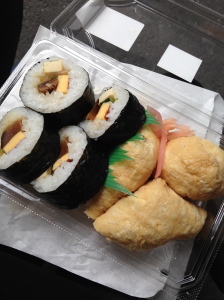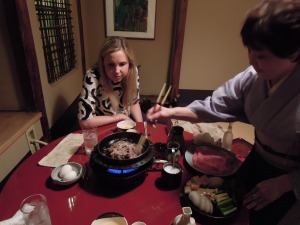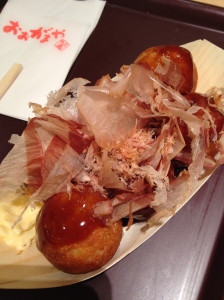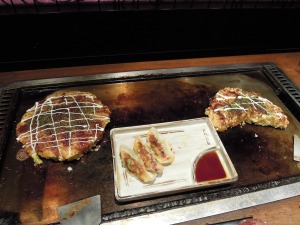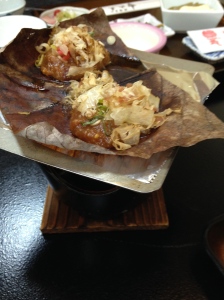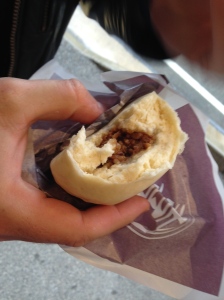Japan’s capital, and residence of the Emperor from 794 until 1868, Kyoto is known for its rich cultural heritage with its temples, shrines and Geisha. It was among one of the few Japanese cities spared in the allied bombings of World War II and thus has maintained beautiful pre-war buildings.
Nishiki Market
We started our exploration of Kyoto’s culinary delights at the Nishiki Market, a bustling five block long market lined with shops and restaurants. There are Kyoto specialties galore with pickles, dried seafood and sushi. As we meandered our way through the narrow street, sampling local delights as we went we foraged for our lunch. We opted for simple and fresh sushi and inari. We perched on small stools in a side street, with our lunch on our laps, and watched the crowds of locals and tourists whiz by.
Pontocho
A lively alley packed with restaurants & bars just of the main shopping district. The coveted Eastern side of the alley overlooks the Kawayuka river with outdoor dining. After a day full of temples, we took a seat on a terrace overlooking the river towards Gion (a cool $20 surcharge for the privilege), and watched the locals go about their day-to-day lives.
On our way to dinner, Robbie, being blessed in the height department spotted a geisha from far off. Having spent the last hour wondering around Gion willing a Geisha to emerge from a teahouse with no result, we felt incredibly chuffed to have seen one walking with quiet intent down the busy street.
We dined in one of the restaurants specialising in sukiyaki. We were quickly, de-shoed and whisked upstairs by our waitress dressed in a kimono and shown to our private room. The thinly sliced, highly marbled beef, cooked at the table with tofu and leafy vegetables with the addition of soy sauce, sugar and water was a taste sensation. Our waitress prepared our first serving, instructing us to dip our meat into a lightly beaten raw egg before devouring. We obliged and combined with sake aplenty, we had a great meal.
Favourite bites
Green tea ice cream
The weather in Kyoto was surprisingly warm (given I had packed for the Antarctic) and after a full day of great sight seeing (Kinkaku-ji & Kiyomizu-dera) we thought we’d treat ourselves with a green tea ice cream. We asked for a small serve in a cone but what we were presented with was the Colosseum of ice creams, complete with crushed green tea biscuits. We were in green tea ice-cream heaven, which was followed closely by a green tea food coma.
Green tea matcha latte
My green tea obsession continued with this smooth and delicious latte made from the powdered leaf. Combined with a brioche bun filled with sweet red bean taste, it made the perfect Japanese breakfast combination. Sugar loaded I was able to attack the day and the sights wholeheartedly.
Takoyaki (Octopus Balls)
A snack born in nearby Osaka, made of a flour-based batter and filled with diced octopus, cooked in a special pan and topped with takoyaki sauce (thick, dark and sweet), mayonnaise and sprinkled with dried bonito. They’re a staple in street food stalls and although I burnt my mouth by scoffing the unexpectedly molten centred ball in one, I’d do it all again and can certainly see why they’re one of the city’s favourite snacks.
Okonomiyaki
Okonomiyaki is a Japanese savoury pancake, the main ingredients being flour, yam, dashi, eggs and shredded cabbage adorned with various meats, vegetables or seafood. When our taxi driver delivered us to our restaurant (Donguri) he said “ahh Japanese pizza”.
It’s another dish that is meant to have originated from neighbouring Osaka. The batter and toppings are pan-fried on both sides and topped with a thick, sweet Worcestershire like sauce, seaweed flakes, bonito flakes and Japanese mayonnaise. We sampled both the pork and mixed seafood variety, both of which were delicious and left us wondering when next we could sample this again back home.
End of the journey
That takes me to the end of our Japanese adventure. The vibrant and energetic cities, combined with a rich cultural heritage and the kindest, friendliest locals, made for a wonderful trip. Not to mention the amazing gourmet delights which the country is famed for! Our eyes, ears and tummies were not disappointed.
Bri xx


